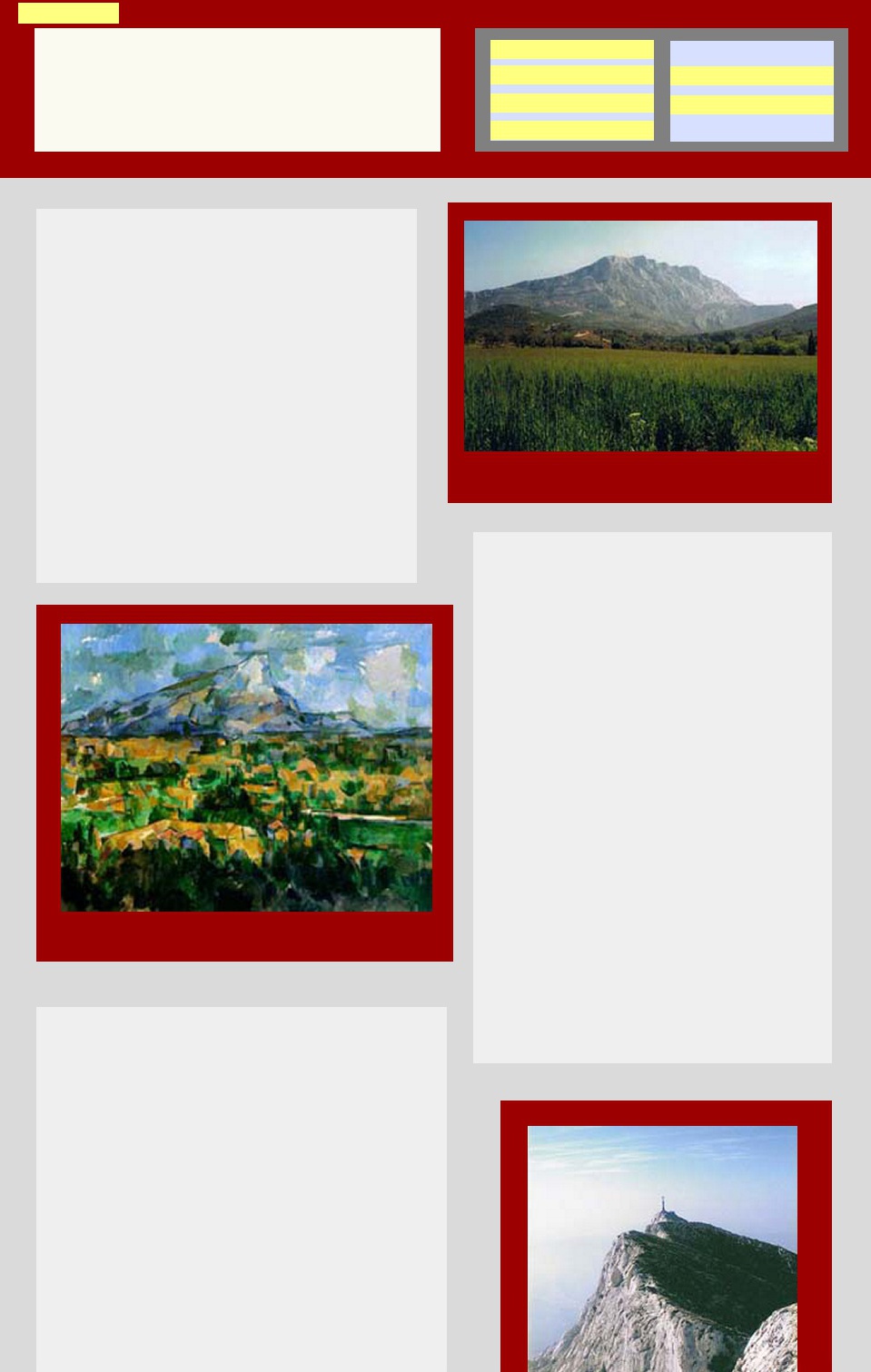

Cezanne's Mountain
Climbing Mt Sainte-Victoire
Paul Cezanne
Paul Cézanne was born in Aix en Provence and grew up there,
first in the town and later in the house his father acquired on the
outskirts of Aix. Towering over the local landscape is the
chunky, irregularly shaped Mt Saint Victoire, with starkly white
limestone cliffs reaching a high point of 1011m. As a boy
Cézanne roamed this countryside with his friend Emile Zola, and
later he would go for long solitary walks, his painting equipment
on his back, climbing Mt Ste Victoire and walking over every
inch of the countryside he loved. The mountain became one of
the focal points of his life and he painted it about 60 times.
Climbing Mt Sainte-Victoire
Walking in this countryside and climbing the mountain is to
walk right into the centre of those colourful paintings. The
stunted grey-green trees and red earth at the base of the
mountain and the stratas of white limestone along the plateau
at the top are unchanged. The climb can be approached from
two directions, either a steep pull up from le Tholonet in the
south or a more gradual, though unrelenting ascent from
Vauvenargues in the north.
We made the pilgrimage on a glorious clear Sunday at the
end of October while staying in the valley in Vauvenargues.
Here our hotel room had a glorious view of the mountain and
a castle where Picasso spent his last years and is buried.
Aix itself would be an equally good base as it is a lively and
interesting large town with lots to keep you occupied on non
walking days.
In the cool of the morning the early stages of the walk were
easy but as the day became hotter, the track started to
climb and eventually emerged from the trees into dazzling
Mediterranean sunlight.
There seemed to be a lot of other people toiling uphill and,
on reaching a little chapel at about 500m, it became
obvious that the stream of people, dressed either in
colourful national costumes or regal clerical robes, had a
loftier purpose than simply reaching the summit. Here it
emerged that the throng included the Archbishop of Aix
who, accompanied by a rather hot and bothered looking
entourage, had also made the climb in order to bless a new
altar in the chapel.
We watched the ceremonies for a while and then
continued up onto the top of the massif where a gigantic
cross stands to dominate the surrounding plain. After a
while the crowd spread out and intermingled with the
weekend picnic activity. People stretched out in the sun
and took photos of themselves in ridiculous positions
leaning out over the edge of the precipices. There was a
wonderfully relaxed picnic atmosphere.
You can walk for up to 9 km along the top of the mountain, on a
sharp stony surface taking care at the slippery and crumbling edges
of the ravines. This is the route of the GR 9 as it starts to sniff the
Mediterranean after its journey south from Lake Geneva.
If it's not too hazy you gaze over the countryside and imagine the
battle in 102 BC when the Roman general Marius slaughtered up to
200,000 members of a "barbarian" army headed towards Rome.
Having themselves suffered great losses, the Romans shadowed
the eastward moving enemy from the high grounds of Mt Ste
Victoire from where the devastating assault was launched. After the
victory Marius was declared a hero, "the saviour of the civilised
world", and whole generations of male babies were subsequently
named Marius
As we made our way down the mountain later in the afternoon,
there were still streams of people labouring up the hill. Towards
the base of the mountain, the track widened out to allow vehicular
traffic and at this point the Archbishop climbed aboard an air
conditioned 4x4 vehicle, and sailed by the walkers waving regally
as he passed.
You can't always do this walk. In summer when the temperatures
are high and strong winds blow there are days of extreme fire
danger when all the tracks up the mountain are closed. In 1989 a
huge fire destroyed all the vegetation and, in the clean-up, some
17 bodies were found. It seems that people are always getting lost
and there is a permanent rescue centre in the valley. As we
settled down to a delicious dinner of Provençal rabbit a loud siren
sounded out across the valley, signalling an incident on the
mountain. The waiter shrugged and showed little interest so we
never discovered the outcome.
Our return to Paris at the end of
this trip had been planned to
co-incide with a monumental
exhibition of Cézanne's work at the
Grand Palais.
There was the mountain on canvas after canvas exploding in colour, painted from every direction and in every season.
There was the mountain on canvas after canvas exploding in colour, painted from every direction and in every season.
The paintings seemed even more
wonderful after our experience on
the mountain itself.
Return to Top
Mt Sainte-Victoire seen from near le Thonolet
Cezanne's Mt Sainte-Victoire
The summit of Mt Sainte-Victoire
The mountain from near le Thonolet
Explore more FRANCE
Visit ITALY
Visit SPAIN/PORTUGAL
Explore on MAPS
Return to HOME PAGE
Explore PHOTO GALLERIES